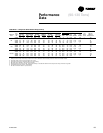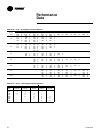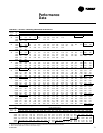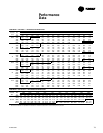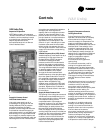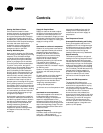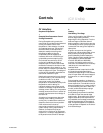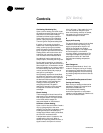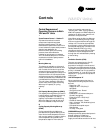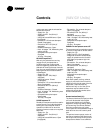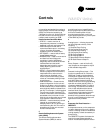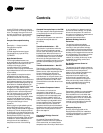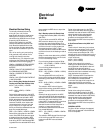
RT-PRC010-EN76
Controls
temperature deadband low end, the
heating valve is modulated open to
maintain the set minimum supply air
temperature.
3
Zone Temperature Control
Unoccupied Zone Heating and Cooling
During Unoccupied mode, the unit is
operated as a CV unit. Inlet guide vanes
and VAV boxes are driven full open. The
unit controls zone temperature within
the Unoccupied zone cooling and
heating (heating units only) deadbands.
Daytime warm-up
This feature is available on all types of
heating units. During Occupied mode, if
the zone temperature falls to a preset,
user-defined zone low limit temperature
setpoint the unit is put into Unoccupied
mode and Daytime Warm-up is initiated.
The system changes over to CV heating
(full unit airflow), the VAV boxes are fully
opened and full heating capacity is
provided until the Daytime Warm-up
setpoint is reached. The unit is then
returned to normal Occupied mode.
4
Outdoor Air CFM Compensation
The purpose of this feature is to
modulate the minimum position of the
economizer to compensate for varying
unit airflows in VAV units, thereby
minimizing the large variation of outdoor
air CFM that can occur. The feature
allows the user to set (calibrate) the
economizer minimum position with inlet
guide vanes (or VFD) at 0 percent and at
100 percent. On units with inlet guide
vanes (or VFD) and economizer, the
minimum position of the economizer is
modulated based on inlet guide vane
position (or VFD speed).
Heating: Hot Water or Steam
On units with hot water or steam
heating, the supply air temperature can
be controlled to a heating set point
during the Occupied mode. The supply
air temperature heating set point and
deadband are user-defined at the Human
Interface Panel. VAV Occupied heating on
hot water and steam heat units is
enabled by closing a field-supplied
switch or contacts connected to an
changeover input on the RTM.
Heating: Modulating Gas
Upon a call for heating, the UCM closes
the heating contacts, beginning the firing
sequence. First, the heat exchanger
combustion blower begins operation.
Upon positive proving of combustion
airflow, a pre-purge cycle is executed.
Then the ignition sequence takes place.
If ignition is not proven, the ignition
transformer is de-energized. After a time
delay, another pre-purge cycle takes
place, followed by another attempt to
ignite. If ignition fails a second time, the
heating section will be shut down and
locked out until manually reset at the
unit mounted Human Interface Panel.
As additional heat is required, the air
damper opens, increasing the firing rate.
During heating operation, an electronic
flame safety control provides continuous
flame supervision. If combustion should
become unstable for any reason, heating
will automatically shut down. After one
minute, another 60 second pre-purge
and ignition cycle begins.
As the heating requirement is satisfied,
the UCM will reduce the combustion air
and the firing rate will lower to maintain
the desired outlet temperature. When
the requirement is fully satisfied, the
heating contacts are opened, de-
energizing the heat. The specific
sequence of operation of the gas heat
will depend on the size of the heat
exchanger.
Supply Air Setpoint Reset
Supply air reset can be used to adjust
the supply air temperature setpoint on
the basis of a zone temperature or on
outdoor air temperature. Supply air reset
adjustment is available from the Human
Interface Panel for supply air heating and
supply air cooling control.
A
reset based on outdoor air temperature
Outdoor air cooling reset is sometimes
used in applications where the outdoor
temperature has a large effect on
building load. When the outside air
temperature is low and the building
cooling load is low, the supply air
setpoint can be raised, thereby
preventing subcooling of critical zones.
This reset can lower usage of
mechanical cooling, thus savings in
compressor KW, but a increase in supply
fan KW may occur.
Outdoor air heating reset is the inverse
of cooling, with the same principles
applied.
For both outdoor air cooling reset and
heating reset, there are three user
defined parameters that are adjustable
through the Human Interface Panel.
- beginning reset temperature
- ending reset temperature
- maximum amount of temperature reset
B
reset based on zone temperature
Zone reset is applied to the zone(s) in a
building that tend to overcool or
overheat. The supply air temperature
setpoint is adjusted based on the
temperature of the critical zone(s). This
can have the effect of improving comfort
and/or lowering energy usage. The user-
defined parameters are the same as for
outdoor air reset.
Supply Air Tempering
Hot water, steam, and modulating gas
units only — When supply air
temperature falls below the supply air
(VAV Units)




